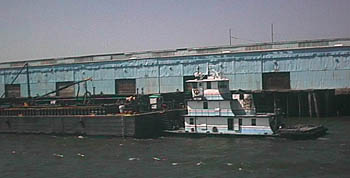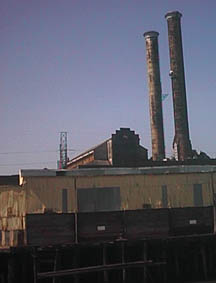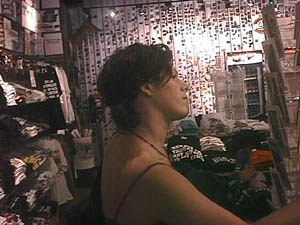|
|
|
Mississippi River boat ride
Wednesday, October 6 1999
In the morning Kim and I caught a ride with Lindsay to her workplace at the Contemporary Art Center, a spacious and thoroughly modernized brick warehouse in (appropriately enough) the Warehouse District. The place wasn't really open yet except for the integral café and free cyberbar. They had Telnet and everything.
Seemingly behind every door was a huge gallery. Lindsay turned on the lights for the ongoing George Dureau photography exhibit and we walked around looking at his black and white prints, mostly full-body shots of semi-naked men, many of whom were missing limbs. They were in the style of Mapplethorpe, but the brochure said Mapplethorpe had learned from Dureau, not the other way around.
Later I showed Lindsay my art on a web browser, but she didn't seem especially impressed by it. She has a disturbing way of making me feel like I'm boring the hell out of her. What sucks is that she's also the sort of person that people like me want to impress. The net result is that I feel diminished every time I hang out with her. Perhaps for someone like me this is a good thing. (Somewhat along this line, during the rest of my vacation, New Orleans itself seemed bored with me even as I sycophantically sought signs that it could see significance in me.)
Kim and I caught a street car northwestward through the city, past Tulane and Loyolla Universities. A 30ish blond girl from San Diego across the aisle made the mistake of responding to a socially persistent crack head in the seat in front of her, and for the rest of the ride he kept trying to continue the conversation. Telephone poles and trees whizzed by, inches outside the open windows. I wondered how many arms and heads had been lost this way.
Cooter Brown's is a bar (with pool tables) near the all-important levee. In an adjacent wing a black woman with silver teeth makes the most wonderful po-boys (huge submarine sandwiches containing typical New Orleans food) you can imagine. The bar is lit almost entirely by the cold glow of the beer refrigerators. We ate our po-boys in a booth in that cold smoky bar. Up above us near the ceiling were the cartoonish effigies of various historical celebrities, all interacting in harmony, each with oversized heads and holding bottles of beer. Pax cervesa.
Kim and I, beers to go in hand, ended up on the levee overlooking the Mississippi on one side and the city of New Orleans on the other. The city is several feet below sea level and contains no natural bodies of water anywhere within it. All the water flow (and make no mistake, there is plenty of water in New Orleans) happens below ground, collected in pipes and lifted out of the city at several different pumping stations. The stations look like old brick firehouses with huge green Bender-robot-arm pipes coming into them. The pumps, I'm told, are completely Y2K compliant owing to their state of the art 1880 technology. Still, nothing about New Orleans can ever really be permanent. If the sea rises too much or the land continues to settle and sink, the energy required to bail out the water will one day be too high. As it is, houses in New Orleans sink at unpredictable rates and "house leveling" is a big business here. No one has basements.
We caught a ride on the John H. Audubon, a mid-size paddle wheel boat heading down the river to the French Quarter. We climbed up on deck where the wind blew strong and we had a commanding view of either side. The captain announced various facts and figures as we set sail. New Orleans is the biggest port in the world. The Mississippi River is 80-100 feet deep at center. New Orleans is 100 miles upstream from the Gulf of Mexico.
As the biggest American port, New Orleans doesn't present a particularly tidy front door to the world's sailors. Some of the wharf areas are so run down, rusted and storm beaten, they wouldn't look out of place in the Third World.
When a boat this size lands, the process of tying up is remarkably similar to landing a row boat. It involves similar human efforts and strong arms. Luckily, extremely large floating objects can be moved by a single human being.
We'd landed near the New Orleans Aquarium, but we decided instead to go to the adjacent facility, an IMAX theatre, to watch a documentary about sealife in an oceanic kelp forest. I'd never been in an IMAX theatre before and all I knew about them was that they are on the "cutting edge" of video experiences. It turned out that it's nothing much more than a retooled and modernized version of a 3D movie experience. The screen is very big and circular, and the audience sits rather close to it in an extremely steep theatre. The individual audience members all wear special glasses and, while they're watching the flick, the screen occupies their entire field of vision. The movie itself had something of a demo quality to it, as if it was made just to showcase the technology, much like the first stereophonic albums. Though it almost gave me a headache, I'd say it was probably worth the $6 each. And despite the whiz bang technology, the movie did nothing to improve the minds of the individual audience members. A redneckish woman just behind us kept commenting her amazement at the wonder of God's creation. But when we got to the part featuring the decidedly Satanic-looking manta rays, she stopped talking.
We tried to rest outside in the shade of a tree, but fire ants (a constant outdoor menace in New Orleans) drove us off. We toured the French Quarter, shopping for an extended period in one of those stores that sells preserved alligator heads and voodoo dolls.
In the evening we ended up at Ed Nelson's place, socializing while various friends of his (and wife Susan) came and went. Ed's little girl is now one years old and has a decidedly wide-eyed fascination with the concept of soap bubbles.
We picked up multiple pasta dinners from a nearby outlet of Semolina and yumpstered the food down. As usual, it was excellent.
Ed broke out some pictures he'd taken at Angola, the Louisiana State Prison in the boondocks near where the Mississippi quits being coy and enters Louisiana in ernest. Ed had gone to Angola on a whim, and had given the prison administrators the excuse that he was there to do work for a school project. But the fact was that he'd just been curious. When he'd seen the ominously indirect sign warning about the risks of carrying drugs into the facility, he'd hid his pot up under the rubber mat beside the pedals of his Volvo.
In one of the photographs, we could see the death row building and the adjacent death house looking not much different than two ordinary whitewashed farmyard outbuildings. In another photo, the electric chair itself looked like it had been built from found parts in a basement by a high school shop class.
Later on, Kim, Ed and I all climbed in the hot tub out back. I might know SQL, Javascript and ASP, but the programming for the jets was completely beyond me.

This warf along the Mississippi wouldn't be out of place in Cambodia.

Rusty factory monuments in riverside New Orleans.

The big bridge entering New Orleans from the south.

Kim shopping in the voodoo store.
For linking purposes this article's URL is:
http://asecular.com/blog.php?991006 feedback
previous | next |



